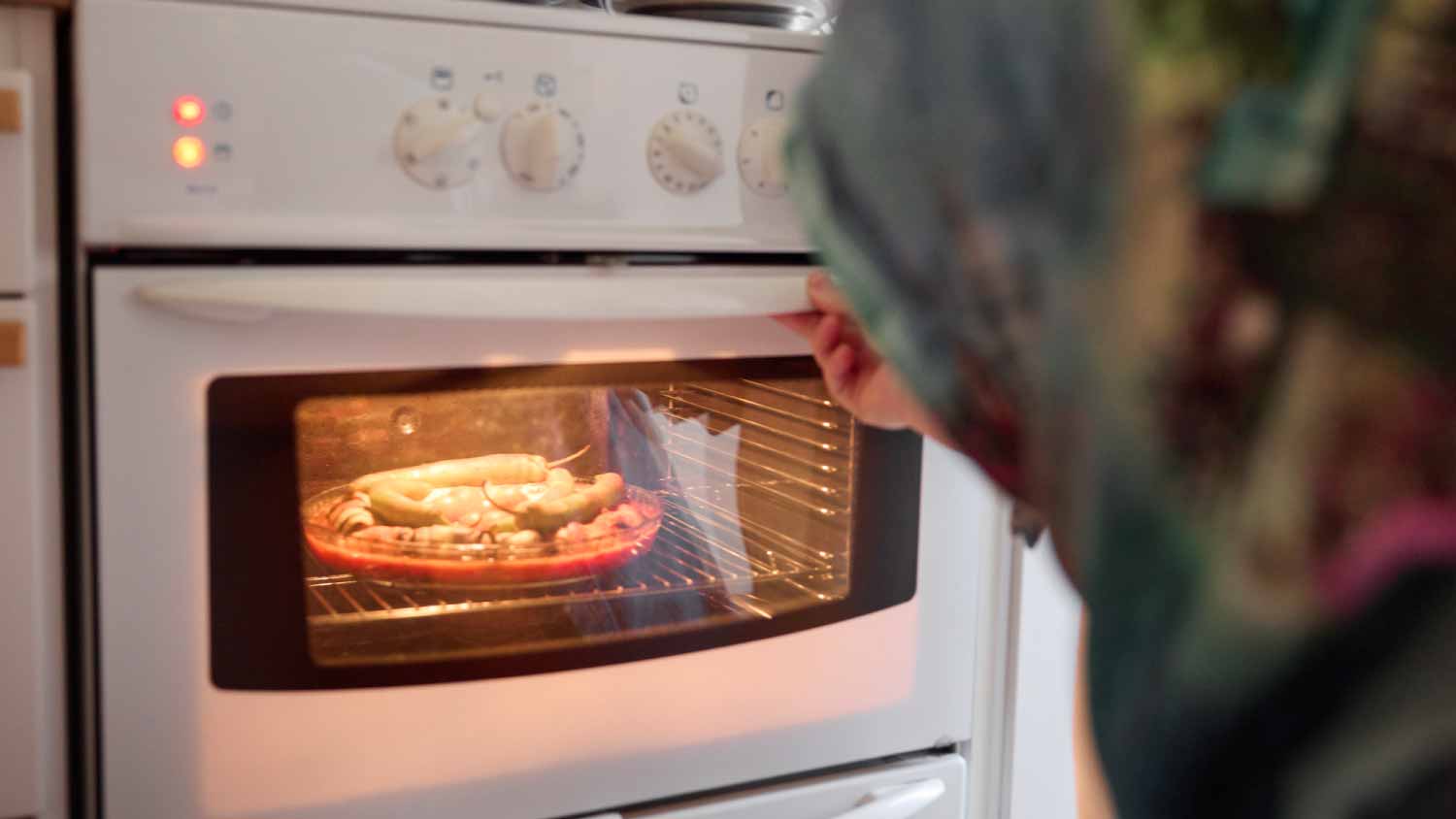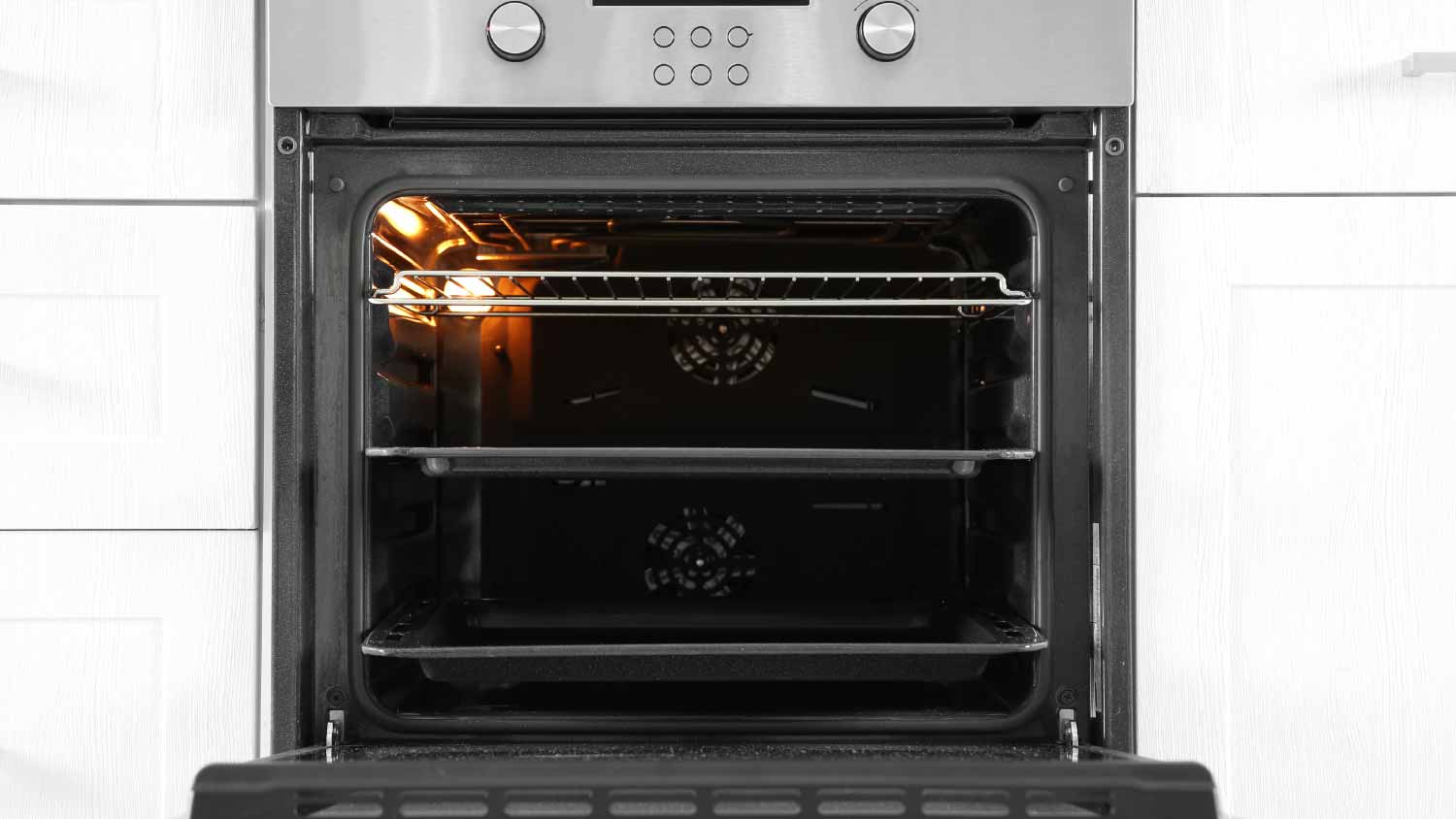
If your refrigerator has been damaged, refrigerator door dent repair cost will vary based on the imperfection's size, depth, and location. Use our guide to estimate how much you'll spend on refrigerator dent repair.
Is this all-the-rage range right for you?


Convection ovens use a fan to circulate hot air throughout the oven cavity.
Conventional ovens heat food using a bottom heating element.
Because of the cooking method, convection ovens cook food faster and more evenly.
Convection ovens tend to be more expensive than conventional ovens.
With the tides turning against the conventional gas range, and the rapid ascent of the air fryer, the typically staid world of the oven has been in turmoil. The words “convection” and “conventional” look similar, but they are two very different styles of cooking in an oven. As you explore ranges for your home, consider whether a conventional oven is right for you or if you’d like the added benefit of having a convection oven, which can cook quicker and more evenly at a lower temperature.
Ovens have been around for centuries. Some of the earliest were simply pits filled with hot coals. Technology has made great strides, of course, and now our ovens self-clean and can be controlled by WiFi. In addition, some of them have convection heating technology, which is a special feature on many newer ovens. There are also some standalone convection ovens; these are usually smaller, countertop models.
The key difference between conventional ovens and convection ovens is the way they heat food. Conventional ovens use a fan and exhaust system to blow heated air evenly throughout the oven to cook your food, while a normal or conventional oven has one source of heat from the bottom of the appliance.
Some cooks like convection ovens because they cook food faster and more evenly. Because the fan circulates the heat around the oven, the temperature stays more consistent than in conventional ovens, which can have areas of warmer air or, conversely, cold spots.

If you have an oven in your home, it’s likely a conventional oven. A conventional oven uses tried-and-true technology: a heat source, usually located on the bottom of the oven cavity, fills the space with hot air to cook food. Many ovens are also able to heat from the top if you wish to broil.
Modern ovens are usually fueled by either natural gas or electricity. When an oven is part of a complete stove range, the fuel used for the oven could be the same or different from the fuel used for the burners on top of the range. Many modern units also have convection cooking functions, giving you lots of flexibility in the kitchen; these units do tend to be more expensive, however, so you should consider if convection cooking is a method you will use frequently enough to justify the cost.
Almost all recipes that require an oven assume you have, and are using a conventional oven.
| Pros | Cons |
|---|---|
| Recipes are often written with conventional ovens in mind | Uneven cooking |
| Familiar cooking method | Longer cook times |
| Gentler for delicate cakes and quick breads | Smaller capacity |
| Less expensive | Higher energy costs |
| Smaller size | Requires more monitoring during cooking |
Best for:
Home cooks who are hesitant to adjust to different cooking methods
Homeowners on a budget
Homeowners with limited space
Many recipes assume you have a conventional oven, which takes a lot of the guesswork out of cooking. Most homeowners have used conventional ovens; they are familiar appliances. New models might have more bells and whistles, such as WiFi connectivity, but overall, they are user-friendly and easy to adapt to any recipe.
Some food items cook better in conventional ovens. Delicake cakes, custards, and quick breads often benefit from the bottom-up heating method.
Finally, conventional oven ranges tend to take up less space than ones with convection technology and are more wallet-friendly.
Compared to convection ovens, food takes longer to cook in conventional ovens since there is no hot fan circulating the air around. As a home chef, expect to check your food more often, too, as conventional ovens often leave hot or cold spots in the oven cavity; your food might not cook uniformly.
Since conventional ovens are smaller, they can’t accommodate as much food, and they require more energy to cook, as you need to set the oven to a higher temperature than you would for a convection oven. This can result in higher energy bills.

A convection oven uses a fan to circulate hot air throughout the oven cavity. This distributes heat evenly throughout the oven, allowing for consistent, evenly cooked food and eliminating the hot or cold spot problem that conventional ovens have. Convection ovens also cook food much faster than conventional ovens, despite often using a lower temperature. Because of this, home cooks often need to adjust recipes to adapt to convection ovens.
Some convection ovens might be labeled as “true convection” or “European convection.” These ovens have a third heating element in addition to the fan, which creates even more reliable cooking.
Many modern oven ranges have convection cooking as a feature; these ovens give you the best of both worlds, allowing you to cook in a conventional way when you need to but have the option of using convection. There are also many countertop convection ovens that can complement an older, or less elaborate, traditional range.
| Pros | Cons |
|---|---|
| Faster cooking | More expensive |
| Even cooking | Recipes must be adapted |
| Energy-efficient; lower temperature required | Learning curve for home cooks |
| Food requires little monitoring | Noisy |
Best for:
Homeowners who want to save on energy bills
Home cooks who want faster, more reliable cooking
For most people, the greatest benefit of a convection oven is its ability to cook food quickly and evenly. You don’t have to worry about hot or cold spots that might cook one side of your lasagna faster than the other; convection ovens blow hot air on all sides of your food to cook it uniformly (and with perfectly crispy edges, if that’s what you’re after).
Because of the way they cook food, they often require a lower temperature. This can save you money on your energy bills (and keep your house cooler in the summertime).
Convection ovens are often more expensive than conventional ovens. Many conventional oven ranges are under $1,000, while convections are $1,000 or more.
Some home cooks might also find themselves frustrated having to constantly adapt recipes for convection cooking; remember that convection ovens cook faster even with a lower temperature, so there might be some trial-and-error, even with recipes you’ve cooked a dozen times.
Finally, some foods, such as custards and quick breads, don’t cook well in convection ovens. Delicate baked goods are better suited for conventional ovens.
Both cook food, but due to their different cooking methods, there are key differences to note between conventional and convection ovens.
Convection ovens cook food quickly and thoroughly, with no hot or cold spots to worry about. Many dishes, such as roasted meats and vegetables, that benefit from a crispy exterior and moist interior, will do well in a convection oven.
Convection ovens require less heat, which requires less energy. Cooking at a lower temperature not only saves you money on your energy bill but keeps your house cooler during heat waves.
Depending on what features are included, many conventional ovens cost less than $800; convection ovens, on the other hand, tend to be $1,000 or more.
Most recipes are written for conventional ovens, so you won’t have to determine a different setting and cooking time as you would for a convection oven.
Convection ovens require more frequent cleaning of the fan for proper airflow. Conventional ovens require periodic cleaning of the interior and exterior.
Convection technology doesn’t change how your oven is installed; what matters is if you have a freestanding or slide-in unit, and whether you’re using gas or electric. Talk to a few nearby appliance installation companies to get installation quotes and understand the process.
From average costs to expert advice, get all the answers you need to get your job done.

If your refrigerator has been damaged, refrigerator door dent repair cost will vary based on the imperfection's size, depth, and location. Use our guide to estimate how much you'll spend on refrigerator dent repair.

Looking to keep warm this winter without the high utility bills? Use this pellet stove installation cost guide to see what a natural heating solution will cost.

Installing a gas dryer can help you save on your monthly energy bills. Depending on whether you need a new gas line, gas dryer installation costs will vary greatly.

A washer that leaks water may have a faulty door seal, gaskets, hoses, pumps, or other parts. Keep reading to find out why your washing machine is leaking water.

There are many different sizes of dishwashers, and which one you choose will depend on whether you want a standard dishwasher size or a custom fit.

Your gas oven might not heat up for various reasons, such as problems with the circuit breaker, igniter, or gas supply. You can troubleshoot to figure out why your gas oven won’t heat up, but you may need to reach out to a professional.